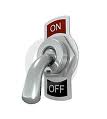Tomorrow June 8th @ SMX Advanced in Seattle I’m digging deep into AdWords Quality Score in the 10AM Session. But I’m not going to have time to cover the issue of what to do with poor performers. This post offers some thoughts on that topic, as an addendum offered in advance. I’ll post some version of the entire presentation online next week. In the dark ages of AdWords, (before quality score) you couldn’t just bid on any old keyword. There was a minimum CTR requirement. When a new keyword was added to your account, Google gave you about 1000 impressions to prove that you could earn a click-through rate of at least 0.05%. If you didn’t meet or exceed that CTR level the word was paused. Game over. Yes, they did allow you to try to improve by writing a new text ad, or editing your bid to test a higher position. But after another 1000 impressions or so, if one-half of one-percent of the users didn’t click, the keyword was shut down again.
The Age of Quality Enlightenment
In the AQ era (after quality score) things are more complex. Poor performing keywords are sometimes denied all impressions, but more often they’re pushed down in position and generally shown less frequently but still shown occasionally. More importantly, you are allowed to compensate for bad quality with high (or extra-high) bids, and still get your ads shown regardless of performance.
Protection From Yourself
 There are many ways to look at this change. Advertisers didn’t like being denied the ability and opportunity to run ads in the rather abrupt way of the old .05% CTR threshold. It wasn’t entirely fair – obviously there is not one ‘good’ CTR for the many categories and business – and it didn’t recognize the different goals and success thresholds of different advertisers. But the willingness and even bravery of Google to deny advertisers the ability to advertise should be considered. They did it to protect user experience – if you couldn’t satisfy or at least interest that tiny percentage of the people that you’re targeting, it does pretty clearly suggest that your ads are disinteresting to a whole lot of people. I think they also did it to stop advertisers from wasting good money after bad, and ultimately having a poor experience themselves. If some of your keywords perform and make money, you keep those and wish you could find more. But if they allowed you to aimlessly run poorly performing ads, at some point it’s likely that you (or whomever is writing your checks) decides that this channel really isn’t working and cuts off all funding. This creation of scarcity – only a limited number of keywords work for you – leaves you willing to bid up those remaining keywords to maximize volume, and builds a desire to work harder to find additional keywords that do perform adquately. But in this world they have to perform or they’ll be turned off. That was a clear signal, and it seems a lot of advertisers needed it.
There are many ways to look at this change. Advertisers didn’t like being denied the ability and opportunity to run ads in the rather abrupt way of the old .05% CTR threshold. It wasn’t entirely fair – obviously there is not one ‘good’ CTR for the many categories and business – and it didn’t recognize the different goals and success thresholds of different advertisers. But the willingness and even bravery of Google to deny advertisers the ability to advertise should be considered. They did it to protect user experience – if you couldn’t satisfy or at least interest that tiny percentage of the people that you’re targeting, it does pretty clearly suggest that your ads are disinteresting to a whole lot of people. I think they also did it to stop advertisers from wasting good money after bad, and ultimately having a poor experience themselves. If some of your keywords perform and make money, you keep those and wish you could find more. But if they allowed you to aimlessly run poorly performing ads, at some point it’s likely that you (or whomever is writing your checks) decides that this channel really isn’t working and cuts off all funding. This creation of scarcity – only a limited number of keywords work for you – leaves you willing to bid up those remaining keywords to maximize volume, and builds a desire to work harder to find additional keywords that do perform adquately. But in this world they have to perform or they’ll be turned off. That was a clear signal, and it seems a lot of advertisers needed it.
The Freedom To Waste Money Endlessly
Today, there is a line below which your ads are ‘not showing’ because your advertising is failing on that keyword. It’s ostensibly based on quality score, but we all know that quality score is just a fancy way of saying click-through-rate. But it’s a more complicated calculation and is highly customized to the keyword – it’s clearly advanced from the old 0.05% and you’re out days. But the line is far lower down the performance spectrum. We’re talking quality scores of 1, 2, and maybe 3 here. These are hideously low CTRs or keywords with terrible relevance. The everyday bad performers are allowed to keep running. Keywords where something is very clearly wrong: those with quality scores of 3, 4, 5, (and even long-standing 6’s). Keywords where you are clearly and plainly underperforming other advertisers. Keywords where your ad copy is not compelling, your offer is not relevant to very many searchers, or something is just wrong. By keeping these keywords running you’re wasting a lot of money. You’re over-paying on a per-click basis for the right to keep these stinkers in the game. And you’re lowering your account CTR history to the detriment of all your good performing keywords. Google lets you pay up and keep spending. You’ll get less impressions per keyword, but with broad or phrase match they’ll find some crazy queries to match you to. You’ll get some clicks and spend spend spend. But how many keywords with quality scores below 7 have ROI’s above 100%? Very very few.
So Why Do It?
 Wouldn’t it be better to turn those keywords off. You tried. It didn’t work. Cut your losses and move on. What is it you expect to change or improve over time? I can think of only three valid reasons to let keywords with quality scores below 7 keep running:
Wouldn’t it be better to turn those keywords off. You tried. It didn’t work. Cut your losses and move on. What is it you expect to change or improve over time? I can think of only three valid reasons to let keywords with quality scores below 7 keep running:
- Profitable. It happens. If you’re making money then more power to you. Let ’em run.
- Rehab. If you’re really working on them, testing new creative, removing any relevance or landing page warnings, refining keywords and negatives and match types to find a winning combination – then by all means keep working while improvement is possible.
- High Cost Low Conversion. As discussed in this earlier post, there are situations, often in B2B primarily, where it makes more sense to focus on conversion rates than CTRs. Managing PPC in this case plays be a different set of rules.
If you really can’t muster the willpower or courage to turn off failing keywords when one of these aren’t true, you really should consider opening a second AdWords account and move them there. At least that way it’s easy to see and measure the cost of this decision, and more importantly the collateral damage of poor lifetime CTR is avoided in your main – and hopefully moneymaking – main AdWords account.



